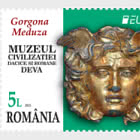Birds Records
Romfilatelia continues the philatelic projects dedicated to fauna, an attractive theme, valued by collectors
and introduces into circulation the postage stamp issue Birds’ Records.
Birds, more than any other group of animals, have always been the object of a special interest on the part of man, both because of their pleasant appearance, the vivid and varied colouring of the feather, the melodious roundelay, but also for their customs of great originality.
The issue, made up of 4 stamps, illustrates record-keeping birds, also present in Romania’s fauna.
The White-Tailed Eagle (Haliaeetus albicilla), illustrated on the stamp with the face value of Lei 2, is the biggest bird of prey in Europe, characteristic of the open regions of the sea coast and the freshwater lakes.
In Romania, the species is endangered, being spread predominantly in the Danube region and the Danube Delta.
It is a sizable bird, of the size of a turkey (80-100 cm), with a weight of 4.10 kg, the male and 5.50 kg, the female. The wingspan ranges between 190-240 cm. Adults have a similar look, the beak and the iris are yellow, the tail is white and the body is brown. Young specimens have dark colour beak, iris, tail and body. They reach the characteristic plumage of the adult in 5-6 years, and the tail becomes completely white only after eight years. The species is a monogamous and tends to keep its mate for the entire life. It nestles in trees near the water, alternately using 2-3 nests, using the same territory. It feeds on fish, water birds, small mammals and sometimes lice.
The Black Woodpecker (Dryocopus martius), illustrated on the stamp with the face value of Lei 5, is the biggest woodpecker in Europe, with dimensions close to those of a crow.
In Romania, it is found in coniferous, broadleaf and mixed forests in the Carpathians, sometimes also in the plain forests, especially in Wallachia.
It is a sedentary and monogamous bird for at least one nesting season. The length of the body is 40-46 cm and weighs 0.25-0.37 kg. The wingspan is about 67-73 cm.
The female has the red spot in the back of the head, while the male has the entire crown of red colour.
The plumage is black. It feeds on insects and their larvae under the bark of the trees.
It is considered a key species in forested areas, providing nesting spaces for many species of birds and mammals. Also, by controlling the insect populations beneath the bark, it protects the trees. It often beats the bum and the knocks, during the nesting season even several hundred times a day.
On the stamp with the face value of Lei 8.50 is illustrated the biggest of the owls, the Eagle Owl (Bubo bubo), a rapacious night-bird. The body length is 58-75 cm and it weighs 1.75-4.50 kg, the female and 1.50-3.20 kg, the male. It is an impressive bird, with wide wings, with the wingspan of about 138-200 cm. It has tussocks above the ears and has large, orange-red eyes. The plumage is yellow-brown and a white spot is visible on the neck.
The species, present on most of the European continent, in wooded areas where the cliffs are associated with forest clusters, especially conifers, is active at night or in twilight and does not have natural predators. It is sedentary, monogamous, sometimes life-long monogamous, and territorial.
It feeds on mammals, ranging from those of the size of an adult rabbit, birds up to the size of herons and buzzards, frogs, snakes, fish and insects. It also attacks by surprise larger mammals such as foxes or baby deer, weighing up to 17 kg.
On the stamp with the face value of Lei 12 is illustrated the Dalmatian Pelican (Pelecanus crispus), the biggest bird as size in its family. It is called Dalmatian Pelicanbecause it has curly and soft feathers on the nape and on the head. The bird has a length of up to 180 cm, measured from the tips of the tail to the end of the beak. Wings, with a span of 270-320 cm, are particularly strong and long, with gray tips, especially visible in flight. It weighs 11-13 kg.
Its body is very strong and heavy, with a long neck, a big head and a beak that can reach 40 cm in length, slightly rounded tail and yellow eyes. A feature of this species is the bag at the base of the beak, which dilates.
The Danube Delta Biosphere Reserveis considered to be one of the most important nesting areas of this magnificent bird. The most important nesting colonies of this species are in the protected area of Rosca Buhaiova, in the area of Lake Zatonul Mic and Zatonul Mare and Lake Sinoe, on a small island named Ceaplace.
The bird, protected and declared monument of nature, migrates in Autumn to the Centre of Africa.
Romfilatelia thanks the “Grigore Antipa” National Museum of Natural History for the documentary support granted for the achievement of this postage stamp issue.
Romania - Recommended stamp issues
WOPA+ recommended stamp issues
| Avatar - Fire and Ash |
| Issued: 03.12.2025 |
| ›New Zealand |
| 50th Anniversary of the Founding of the 24th November Bar Scout |
| Issued: 24.11.2025 |
| ›Montenegro |
| Krisjanis Valdemars |
| Issued: 02.12.2025 |
| ›Latvia |
| Sign Language - Good |
| Issued: 02.12.2025 |
| ›Bosnia and Herzegovina - Republic of Srpska |
| In Memory of the Fallen and Murdered on October 7, 2023 |
| Issued: 08.10.2025 |
| ›Israel |
| Annual Collection Folder (New York) |
| Issued: 05.12.2025 |
| ›United Nations |
| Year Set |
| Issued: 24.11.2025 |
| ›Isle of Man |
| Shipping in the 17th and 18th Centuries - Peat Shipping |
| Issued: 05.12.2025 |
| ›Netherlands |












































